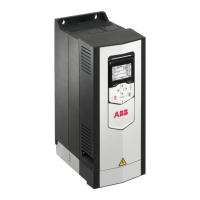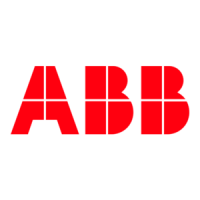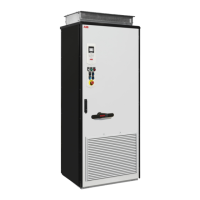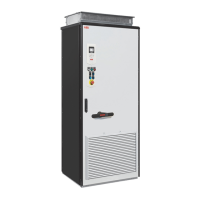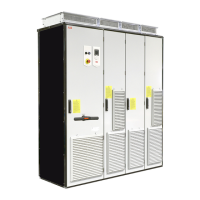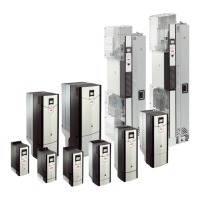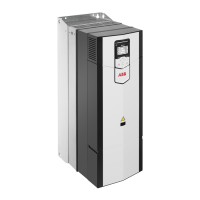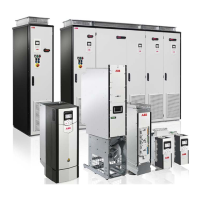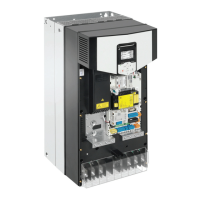Do you have a question about the ABB ACS880-01-430A-3+N5350 and is the answer not in the manual?
Information for planning, installation, start-up, operation and servicing of the ACS880+N5350 Cooling Tower Drive.
Contains safety instructions to prevent injury, death, or equipment damage when installing, operating, or servicing the drive.
Details electrical safety precautions for drive installation and maintenance.
General safety instructions for handling and installing the drive unit, including warnings about hot surfaces and debris.
Safety precautions for handling printed circuit boards, emphasizing electrostatic discharge sensitivity.
General safety guidelines for starting up and operating the drive, including precautions for power-ups and safety circuits.
Describes the ACS880+N5350's purpose, design for cooling tower fans, and availability in various frame sizes.
Details the segmentation of connections into Power and Control, emphasizing the need for separation to prevent electrical noise.
Provides electrical ratings, model numbers, and frame sizes for standard ACS880+N5350 models.
Provides specifications for copper conductors, including metric and US wire gauge ranges for different models.
Lists the recommended tightening torques for power terminals (wire screw and terminal nut) for various ACS880+N5350 models.
Specifies wire sizes and tightening torques for control wiring, applicable to both stranded and solid wiring.
Provides critical safety instructions for proper grounding of the drive system to ensure personnel safety and reduce interference.
Explains how to protect the drive and input cable from short-circuits using fuses, specifying their purpose and the need for fuses with circuit breakers.
Provides tables to guide the selection of wire gauge and input fuses based on control rating and maximum continuous current.
Details the wiring requirements for connecting the drive to the motor, including ground wire and output power termination.
Explains how drive output pulses can stress motor insulation and cause bearing currents, and mentions optional protective filters.
Describes the 9 digital inputs for controlling the cooling tower fan and their connection terminals.
Describes the standard analog input for controlling cooling tower fan speed and the provision of a +10V reference signal.
Explains the use of relay outputs for reporting internal states and lists the three Form-C relay outputs provided.
Describes the two analog outputs for indicating signals like motor speed and torque, and provides technical data.
Details the procedure for checking insulation resistance of cables and the motor using a 1000VDC measuring voltage.
Provides a step-by-step guide for connecting power cables, including grounding conductors and motor cables.
Guides the connection of control cables, including grounding shields and connecting conductors to the control board.
Describes how to install and start up the Assistant control panel for the first time.
Guides through the initial start-up of the control panel, including language selection and basic setup assistant.
Outlines the main components of the user interface: Home view, main Menu, Options menu, and Help view.
Explains that the Home view is the main view for monitoring drive status like speed, torque, and power.
Provides a table of common tasks like starting/stopping the drive, setting references, and switching control modes.
Explains how to hide/view faults and warnings, open help pages, reset faults, and view fault/warning history.
Describes the default 2-wire operating mode for controlling the cooling tower fan using a single off-on switch.
Explains the 3-wire operating mode, which uses momentary start and stop pushbuttons for fan control.
Describes the process control mode, which provides an auxiliary closed-loop PID setpoint control for various configurations.
Explains how the drive can be connected to an external control system via an optional fieldbus adapter or embedded fieldbus port.
Describes the trickle current heating feature for maintaining motor power during standby and preventing condensation.
Details parameters for trickle current enable, power, and delay time, including CTDD assistant access.
Describes the De-Ice function for low-speed reverse operation to prevent ice buildup in colder climates.
Details parameters for enabling De-Ice, setting speed, run time, and accessing it via CTDD assistant.
Explains access levels (CTDD User, Fieldbus, Expert Commissioner) based on passcode and their effect on parameter access.
Shows an example connection diagram for the 2-wire operating mode using a manual disconnect switch.
Depicts an example connection diagram for the 3-wire operating mode using momentary start/stop pushbuttons.
Describes the basic startup assistants for motor data, ID run, and setting up the ACS880 drive with the CTDD program.
Guides through the initial startup process, including safety checks, language selection, and motor data setup.
Continues the initial startup guide, detailing the motor data and ID run assistant flow.
Instructs to refer to the motor nameplate for entering parameters like motor type, nominal current, and voltage.
Details entering motor data such as type, back EMF voltage, nominal current, and the autophasing process for ID run.
Explains how to perform the motor ID run, including standstill ID run and the necessary local control activation.
Describes how the ID run progress is displayed and what to do if motor data is incorrect.
Guides on performing a direction test and completing the motor set-up, connecting I/O as per the user manual.
Describes selecting the CTDD Setup assistant for the cooling tower application after motor data start-up.
Describes how to select the operating mode (e.g., 2-Wire, 3-Wire, PID, Fieldbus) for the CTDD application.
Introduces warnings and faults, explaining how they are annunciated and how faults can be reset.
Covers start/stop modes, emergency stop, signal source selection, DC magnetization, and autophasing.
Covers speed controller settings, including used speed feedback and proportional gain.
Displays limit word 1, indicating various drive operation limits such as torque, speed, and frequency.
Defines the maximum allowed speed for the drive, with warnings about setting it too low.
Covers configuration of external events and selection of drive behavior upon fault situations.
Details parameters for total trials time, delay time for automatic resets, and supply phase loss reaction.
Covers settings for the internal brake chopper, including resistor temperature, enable options, and thermal time constant.
Provides settings for energy saving calculators, including saved energy in GWh and MWh.
Includes settings for speed supervision, actual signal filtering, and general scaling for parameters.
Defines the maximum speed value used for acceleration and deceleration ramp rates, and for 16-bit scaling.
Details configuration for the embedded fieldbus interface, including protocol, node address, baud rate, and parity.
Details parameters for trickle current enable, level, and delay time, including its preventative function.
Outlines parameters for the De-Ice function, including enable, speed, and run time settings.
Covers parameters for autophasing current and time, operating mode selection, and CT minimum speed.
Covers parameters for motor type, control mode, nominal current, back EMF voltage, and nominal frequency.
Selects the type of motor identification routine (ID run) to be performed at the next drive start.
Introduces warnings and faults, explaining how they are annunciated and how faults can be reset.
Describes how to access the event log, view auxiliary codes, and find parameters containing warning/fault information.
Lists warning messages alphabetically, including fault numbers, causes, and recommended actions for troubleshooting.
Continues the list of warning messages, covering external temperature, IGBT overtemperature, cooling, and PU communication issues.
Lists more warning messages, including motor stall, fan issues, safe torque off, and communication errors.
Lists fault messages alphabetically, including fault numbers, causes, and troubleshooting actions for calibration, overcurrent, and earth leakage.
Lists fault messages related to DC link overvoltage/undervoltage, standby timeout, output phase loss, and autophasing.
Covers faults related to motor cable overload, IGBT overtemperature, fan issues, STO hardware failure, and PU logic errors.
Explains how ambient temperature, altitude, and low noise control mode affect drive output current and power.
Details EMC requirements and provisions for Categories C2 and C3 drives, including warnings about radio interference.
Provides a checklist for UL-compliant installations, covering environment, temperature, circuit protection, and cable ratings.
Provides safety warnings for frame sizes R6 to R9 regarding lifting eyes and avoiding tilting due to the drive's weight.
Details requirements for the installation site, including upright position, wall suitability, ventilation, and free space.
Provides instructions for installing the drive, specifically for frames R1 to R4 without vibration dampers.
Guides through setting up the ACS880 Cooling Tower Drive for monitoring and control over Modbus TCP.
Details the steps for setting up Modbus TCP communication, including parameter configurations for Fieldbus Adapter and Operating Mode.
Explains the Control Word bit structure for controlling drive functions like trickle heating, De-Ice, and start forward.
Provides troubleshooting tips for Modbus TCP communication, including verifying CW, speed reference, and SW values.
Guides through setting up the ACS880 Cooling Tower Drive for monitoring and control over Modbus RTU using the built-in D2D port.
Details parameter settings for Modbus RTU setup, including CTD Motor Control and Trickle/De-Ice selections.
Lists configuration parameters for the embedded fieldbus interface, including protocol, node address, and data mapping.
Specifies digital inputs required for Fieldbus Control Mode and details Control Word bit structure for drive control.
Provides troubleshooting steps for Modbus RTU communication, including verifying CW, speed reference, and SW values.
Guides through setting up the ACS880 Cooling Tower Drive for monitoring and control over Ethernet/IP.
Details parameter configurations for Ethernet/IP setup, including Fieldbus Adapter and IP settings.
Details programming the 16-bit transparent assembly instances, input/output assembly instances, and configuration for the drive.

